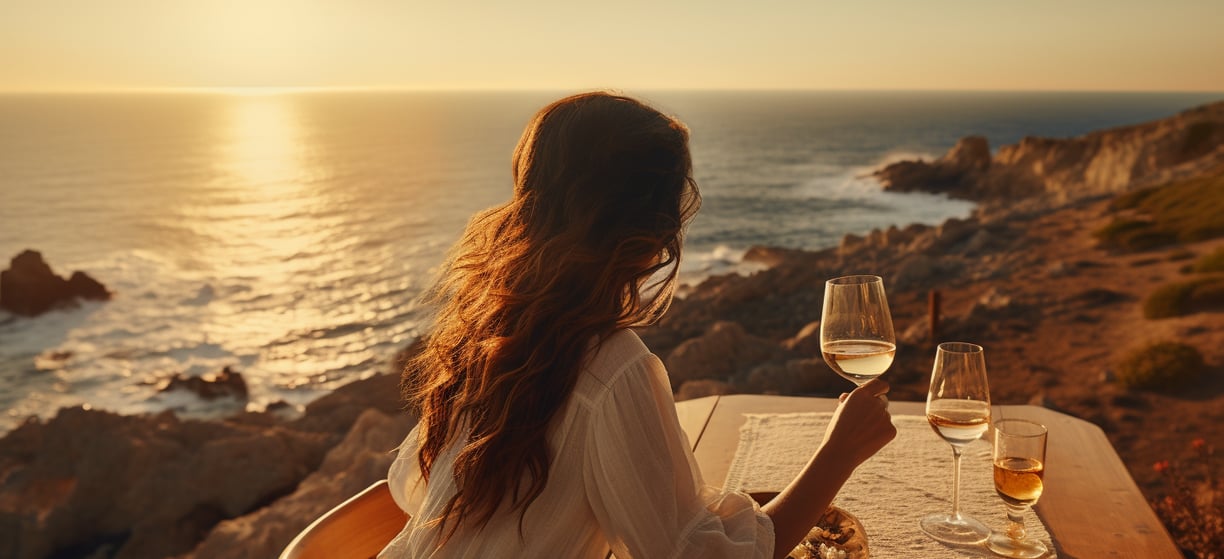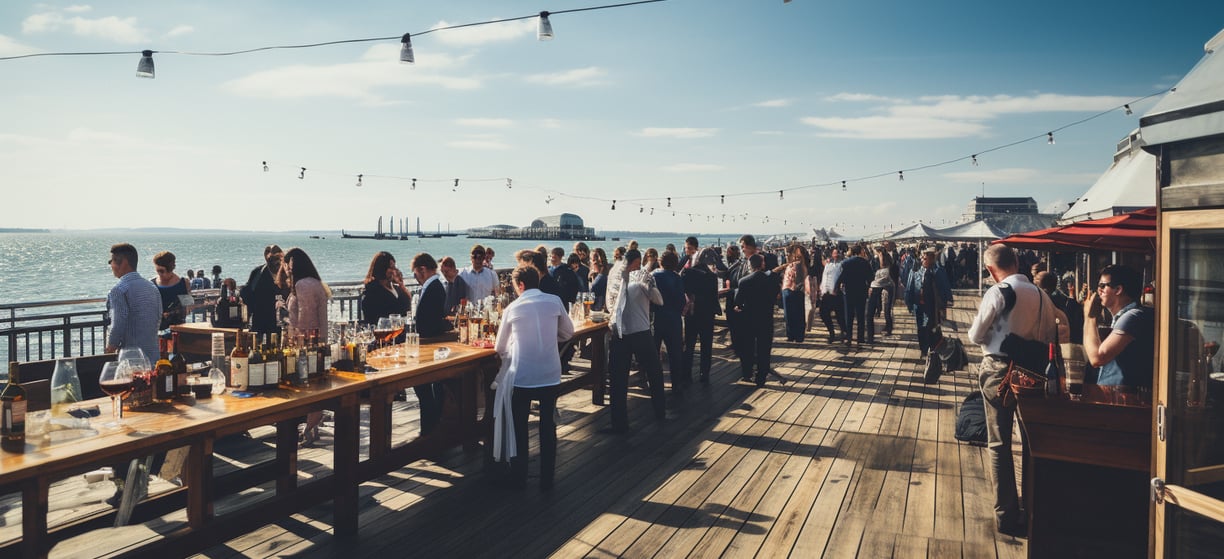Wine Tasting by the Ocean: A Sensory Experience

Imagine yourself on a picturesque beach, the warm sand beneath your toes and the sound of crashing waves filling the air. Now, add to this idyllic scene the rich aromas and flavors of exquisite wines. This is the essence of wine tasting by the ocean - an immersive sensory experience that combines the beauty of nature with the pleasure of indulging in fine wines.
Understanding the Basics of Wine Tasting
Before we dive into the unique world of wine tasting by the ocean, let's start with the basics. To truly appreciate a glass of wine, one must engage all of their senses. It begins with the art of observing wine - taking in its color, clarity, and the way it shimmers against the sunlight.
When it comes to color, wine can range from pale straw-like hues in white wines to deep ruby or purple tones in red wines. The color of a wine can provide clues about its age, grape variety, and even the winemaking process. For example, a young white wine might have a greenish tint, while an aged red wine may show signs of brick or orange around the rim.
Clarity is another important aspect to consider. A clear wine indicates that it has been properly filtered and is free from any sediments or impurities. On the other hand, a hazy or cloudy appearance might suggest that the wine has undergone minimal filtration or is a natural wine.
As you hold the glass up to the light, you may notice how the wine shimmers and glows. This visual characteristic, known as the wine's "legs" or "tears," can provide insights into its alcohol content and viscosity. The slower the wine drips down the side of the glass, the higher the alcohol content and the more full-bodied the wine tends to be.
Next, we delve into the olfactory aspect, where we learn to smell wine correctly and identify the various aromas that dance within the glass. Swirling the wine gently in the glass helps to release its aromatic compounds, allowing us to fully appreciate its bouquet. As we bring the glass to our nose, we may detect a wide range of scents, from fruity and floral notes to earthy and spicy undertones.
The aromas in wine are influenced by several factors, including the grape variety, the terroir (the unique combination of soil, climate, and geography where the grapes are grown), and the winemaking techniques employed. For example, a Chardonnay from a cool climate region might exhibit crisp apple and citrus aromas, while a Syrah from a warmer region might showcase blackberry and pepper notes.
Lastly, we explore the importance of tasting notes and how they help us articulate our experience. When we take a sip of wine, our taste buds come alive, allowing us to perceive its sweetness, acidity, bitterness, and other flavor components. Tasting notes help us describe these sensations in more detail, enabling us to communicate our impressions to others and remember our favorite wines.
When it comes to sweetness, wines can range from bone-dry to lusciously sweet. Acidity adds brightness and freshness to a wine, while bitterness can come from the grape skins or the oak aging process. Other flavor components, such as tannins in red wines or minerality in white wines, contribute to the overall complexity and structure of the wine.
By understanding the basics of wine tasting, we can embark on a journey of exploration and discovery. Each glass of wine becomes an opportunity to engage our senses, unravel its story, and appreciate the craftsmanship that goes into every bottle.
The Influence of the Ocean on Wine Tasting
Now, let's uncover the unique influence of the ocean on wine tasting. The sea breeze, gently caressing the vineyards along the coast, plays a crucial role in shaping the flavors of the wines produced in these regions. The salt-kissed air infuses the grapes, adding a distinct character that sets coastal wines apart. The coastal climate itself, with its warm days, cool nights, and moderate humidity, creates the perfect environment for vineyards to thrive and produce exceptional wines.
Imagine standing in a vineyard, overlooking the vast expanse of the ocean. As the waves crash against the shore, the salty mist carried by the breeze envelops the grapevines, leaving a subtle trace of the sea in every grape. This unique coastal influence is what gives wines from these regions their distinctiveness.
It is not just the salt in the air that affects the grapes. The ocean also plays a role in regulating the temperature of the vineyards. During the day, the sun warms the coastal vineyards, allowing the grapes to ripen to perfection. However, as the sun sets and the cool ocean breeze sweeps in, the temperature drops, preserving the acidity and freshness of the grapes. This diurnal temperature variation, characteristic of coastal regions, is a key factor in producing wines with balanced flavors and vibrant acidity.
Furthermore, the moderate humidity near the coast helps to prevent excessive evaporation of water from the soil. This ensures that the grapevines have a steady supply of moisture, allowing them to grow healthy and strong. The combination of warm days, cool nights, and moderate humidity creates an ideal microclimate for grape cultivation, resulting in wines that are rich in flavor and complexity.
Coastal vineyards also benefit from the unique soil composition found near the ocean. Over time, the constant interaction between the land and the sea has led to the deposition of minerals and nutrients in the soil. These minerals, such as calcium, magnesium, and potassium, are essential for the healthy growth of grapevines and contribute to the overall flavor profile of the wines produced in these regions.
As you take a sip of a coastal wine, you can almost taste the essence of the ocean. The flavors are vibrant and refreshing, with hints of brine and minerality that transport you to the seaside. Whether it's a crisp white wine or a bold red, the influence of the ocean adds a layer of complexity and character that is truly unique.

Pairing Wine with Seafood
As we explore the connection between wine and the ocean, it is only fitting that we delve into the art of pairing wine with seafood. Fish dishes, delicately cooked to enhance their natural flavors, call for wines that complement rather than overpower. Whether it's a delicate white fish or a robust salmon, we will guide you to the best wines that elevate your seafood dining experiences. And let's not forget about shellfish - from succulent oysters to plump prawns, we will uncover the perfect wine matches that will leave you craving for more.
When it comes to pairing wine with seafood, the key is to find a balance that enhances the flavors of both the dish and the wine. For delicate white fish such as sole or halibut, a crisp and refreshing white wine like Sauvignon Blanc or Pinot Grigio can be the perfect match. These wines have bright acidity and citrus notes that complement the subtle flavors of the fish without overpowering them.
On the other hand, if you're indulging in a rich and flavorful salmon dish, you'll want a wine that can stand up to its robustness. A medium-bodied red wine like Pinot Noir or a light-bodied red like Gamay can provide a beautiful contrast to the fatty and oily nature of salmon. These wines have enough acidity and fruitiness to cut through the richness of the fish, creating a harmonious pairing.
Now, let's turn our attention to the world of shellfish. Oysters, with their briny and delicate flavors, are often enjoyed with a glass of Champagne or sparkling wine. The effervescence and crispness of these wines cleanse the palate after each slurp, allowing you to fully appreciate the subtle nuances of the oysters.
For those who prefer prawns or other shellfish, a dry and aromatic white wine like Riesling or Albariño can be an excellent choice. These wines have a touch of sweetness that complements the natural sweetness of the shellfish, while their vibrant acidity cuts through any richness, leaving your taste buds refreshed and wanting more.
As you explore the world of wine and seafood pairings, remember that personal preferences play a significant role. Don't be afraid to experiment and discover your own unique combinations. The possibilities are endless, and with each new pairing, you'll uncover a new dimension of flavors and aromas that will enhance your dining experience.

Organizing a Beachside Wine Tasting
Now that you're longing for the taste of the ocean and fine wines, let's talk about organizing your very own beachside wine tasting. Choosing the right location is essential - think private islands, exclusive coastlines, or hidden coves that provide the perfect backdrop for your sensory adventure. And when it comes to selecting the wines for your tasting, our expert recommendations will ensure that each sip is a moment of pure bliss.
The Sensory Experience of Wine Tasting by the Ocean
Immerse yourself in the sensory experience of wine tasting by the ocean. Let's start with the visual aspect - imagine holding a glass of ruby red wine against the backdrop of crashing waves, witnessing the harmony between nature's palette and the rich hues of the wine. Then, close your eyes and inhale deeply, allowing the wine aromas to mingle with the salty sea air. Finally, take a sip and savor the flavors that come alive on your palate, perfectly enhanced by the gentle touch of the ocean breeze.
The Gustatory Aspect: Wine Flavors and Salty Breeze
As you continue your wine tasting journey by the ocean, the gustatory aspect takes center stage. Allow the flavors of the wine to unfold on your tongue, paired with the salty breeze that envelops you. Experience the delicate interplay between the salty notes of the sea and the complex layers within each sip of wine. Let your taste buds be delighted as you discover the exquisitely balanced flavors that can only be found in wines that have been touched by the ocean.
Now that you have explored the wonders of wine tasting by the ocean, it is time to embark on your own journey. Seek out vineyards nestled along breathtaking coastlines, indulge in the flavors of the sea paired with the perfect wines, and immerse yourself in the sensory experience that awaits. Whether you are planning a trip to renowned wine regions or dreaming of your next beachside escape, let the allure of wine tasting by the ocean be the inspiration that fuels your travel goals. Raise your glass and toast to the beauty of the oceans and the wonders they bring to our palates.